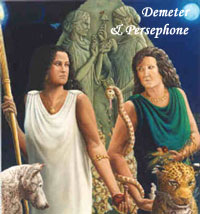![]()
Throughout the course of mankind's history, the Earth's bountiful harvest has been celebrated with ceremonies of giving thanks. Prior to the establishment of formal religions, many ancient tillers of the ground believed that their crops contained spirits...spirits which caused the crops to grow and to die. The belief was also strong that these spirits would be released when the crops were harvested. Therefore, they had to be destroyed or they would wreak revenge upon the harvesting farmers. Some of these ancient rituals celebrated the defeat of such spirits. As time went by the perspective shifted from rituals to defeat spirits to the realization that the fall harvest must take an agricultural society through winter, and thus is vitally important for survival. Whatever power provides that bounty deserves praise. So cultures the world over - Greeks, Romans, Hebrews, Chinese and Egyptians have all given thanks for a bountiful harvest. They might have differed in their forms and presentations. But their spirit - setting aside a date to reflect on life's blessings, remains the same. We have tried to provide a kaleidoscope, depicting the spectra of celebration as practiced by these different cultures.
The GreeksA similar festival was held in Ancient Greece, in honor of the goddess who taught mankind to tend the soil, during a month known as Pyanopsion (Puanepsion), according to the lunisolar calendar of the Athenians. Since our calendar is solar, the month doesn't exactly match, but Pyanopsion would be, more or less, October into November.
 Demeter's
daughter, Persephone, was abducted by Hades, the god of the underworld.
Demeter, the source of all growth and life, withdrew her powers from the
earth during her time of grief. Demeter's refusal to eat or feed the world
until the other gods arranged a satisfactory resolution to her conflict
with Hades over Persephone brought on winter and no plants or grains could
grow. Because Persephone had eaten pomegranate seeds given to her by
Hades, she was condemned by the gods to spending half of the year in the
underworld and half of the year upon the earth with Demeter. Every year
when Persephone is in the underworld, there is winter, when she is on the
earth there is spring and summer.
Demeter's
daughter, Persephone, was abducted by Hades, the god of the underworld.
Demeter, the source of all growth and life, withdrew her powers from the
earth during her time of grief. Demeter's refusal to eat or feed the world
until the other gods arranged a satisfactory resolution to her conflict
with Hades over Persephone brought on winter and no plants or grains could
grow. Because Persephone had eaten pomegranate seeds given to her by
Hades, she was condemned by the gods to spending half of the year in the
underworld and half of the year upon the earth with Demeter. Every year
when Persephone is in the underworld, there is winter, when she is on the
earth there is spring and summer.
On the 11-13 of Pyanopsion, Greek matrons took a break from their usually homebound lives. They participated in the autumn sowing (Sporetos) festival known as Thesmophoria. Although the practices are a mystery, the matrons appear to have symbolically relived the anguish of Demeter and to have asked for her help in obtaining a bountiful harvest. After her resolution with Hades , Demeter gave the gift of agriculture to mankind and every year after her reunion with her with her daughter, Demeter blesses the crops.
The ancient Greeks worshipped Demeter as their goddess of all grains. Each autumn the festival of Thesmosphoria was held to honor the goddess.The first day of the Thesmophoria itself was Anodos, the ascent. Married women, with all the supplies they would need for two nights and three days, they ascended a hill - Thesmophorion (the hillside sanctuary of Demeter Thesmophoros). Then they would build leafy shelters and furnish them with couches made with plants and then slept in these two-person leafy huts.
The second day of the Thesmophoria was the Nesteia (Fast) when women fasted. They may also have whipped each other with bark scourges.
The third day of the Thesmophoria was the Kalligeneia (Fair Offspring). Commemorating Demeter's torchlight search for her daughter Persephone, there was a night-time torch light ceremony. A feast was held and offerings to the goddess Demeter were made - gifts of seed corn, cakes, fruit, and pigs. It was hoped that Demeter's gratitude would grant them a good harvest.
![]()
 The
Romans
The
Romans
The Roman celebration of Cerelia, a harvest festival, was dedicated to the honor of Ceres (Demeter). Daughter of Saturn and Ops, and the wife of Jupiter, she was their goddess of corn (from which the word cereal comes). The same Greek mythology of Proserpina (Prosphene) her daughter's abduction by Pluto (Hades) is also found in the Roman beliefs and forms the basis of Cerelia. It was also an autumnal festival held each year on October 4th but some put the date at April 12th and 14th, and hence coinciding with the arrival of spring with the return of Prosphene back to her mother Ceres. Whatever be the date offerings of the first fruits of the harvest and pigs were made to Ceres. The celebration included music, parades, games and sports and a thanksgiving feast.
![]()
Jewish families also celebrate a harvest festival which they call Sukkoth. Taking place each autumn, the Hebrew Sukkoth has been celebrated for over 3000 years and is known by two names: Hag ha Succot, meaning "Feast of the Tabernacles" and Hag ha Asif, meaning "Feast of Ingathering." Sukkoth begins on the 15th day of the Hebrew month of Tishri, five days afterYom Kippur...the most solemn day of the Jewish year.
Sukkoth takes its name from succots, the huts in which Moses and the Israelites lived as they wandered the desert for 40 years before reaching the Promised Land. Succots were made of branches and were easy to assemble, take apart and carry.
 When
celebrating Sukkoth, which lasts for eight days, the Jewish people build
small huts of branches which recall the tabernacles of their ancestors.
These huts are constructed only to serve as temporary shelters. The
branches are not driven into the ground and the roof is covered with
foliage which is spaced to allow light to filter through. Inside the huts
are hung fruits and vegetables, including apples, grapes, corn and
pomegranates. On the first two nights of Sukkoth, families eat their meals
in the huts beneath the evening sky.
When
celebrating Sukkoth, which lasts for eight days, the Jewish people build
small huts of branches which recall the tabernacles of their ancestors.
These huts are constructed only to serve as temporary shelters. The
branches are not driven into the ground and the roof is covered with
foliage which is spaced to allow light to filter through. Inside the huts
are hung fruits and vegetables, including apples, grapes, corn and
pomegranates. On the first two nights of Sukkoth, families eat their meals
in the huts beneath the evening sky.
![]()
The ancient Chinese celebrated their harvest festival, known as Chung Ch'ui, with the full moon that fell on the 15th day of the 8th month. This day was considered the birthday of the Moon and special "moon cakes," round and yellow like the moon, would be baked. Each cake was stamped with the picture of a rabbit since it was a rabbit, and not a man, which the Chinese perceived to be on the face of the Moon. Families would gather together to partake of a thanksgiving meal, feasting on roasted pig, harvested fruits and the "moon cakes." It was believed that during the three-day festival of Chung Ch'ui, flowers would fall from the Moon and those who saw them would be rewarded with good fortune.
According to legend, Chung Ch'ui was also an occasion to give thanks for another special occasion. China had been conquered by enemy armies who took control of native homes and provisions. The Chinese found themselves homeless and without food. Many of them staved. In order to free themselves they decided to attack the invaders.
The women baked special "moon cakes" which were distributed to every family. Each cake contained a secret message indicating the time to attack. The invaders were so surprised at the unexpected assault that they were easily defeated. Every year "moon cakes" are said to be eaten in memory of this magnificent victory.
![]()
| The ancient Egyptians celebrated their harvest festival in honor of Min, God of Vegetation and Fertility. The festival of Min was held during the springtime...the Egyptian's harvest season. It featured a parade in which even the Pharaoh took part. After the parade a great feast was held complete with music, dancing, and sports. When Egyptian farmers harvested their corn, they wept and pretended to be grief-stricken in order to deceive the spirit which they believed dwelt within the corn. If this was not done, they feared that the spirit would become angry when they cut down the corn in the place where it lived. |  |
![]()
This was a brief glimpse of the overwhelming unity in the spirit of the thanksgiving celebration in all ancient cultures across the world. Prayer, parade, feast and the fervor are common to most of them, though the mode of celebration differs. Today, Annual Days of Thanksgiving are celebrated in the United States, Canada, Japan, South Korea, the Philippines, Laos, Liberia, Puerto Rico, Guam, Grenada and the Virgin Islands. Let us celebrate the true spirit of Thanksgiving.
![]()
| Holiday Index | Leisure Index | Thanksgiving Index | |
Contact Us |
Refer this page | ||